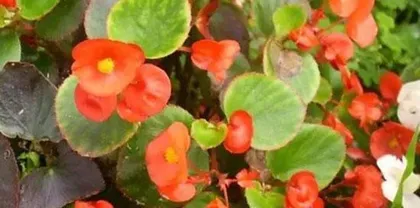Perennial begonia is a common ornamental plant. While its flowers are brilliant and colorful, it is also known as the "everlasting flower". However, in winter, these delicate flowers may be damaged by low temperatures, affecting their normal growth. We should master some winter care techniques to help the perennial begonia survive the winter healthily.

1. Understand the Growing Environment and Characteristics of Perennial Begonia
Perennial begonia prefers a sunny, cool, and moderately humid environment. It has high temperature requirements, with the most suitable growth temperature in summer being 18-25°C, and it needs to be maintained at around 5-10°C in winter. Temperatures that are too high or too low will affect its normal growth.
2. Maintain a Suitable Temperature
In winter, we should keep the perennial begonia in a temperature environment of 5-10°C. If the indoor temperature is too high, it can be lowered by ventilation, humidification, and other methods to avoid overheating. Also, do not expose it to cold winds to avoid affecting its growth.

3. Reasonably Control Watering and Fertilization
Perennial begonia grows slowly in winter and does not require much water or nutrients. Generally, water it once a week to keep the soil moist, but also pay attention to avoiding excessive water that can lead to root rot. For fertilization, you can apply organic fertilizer or compound fertilizer once a month.
4. Reduce Moving and Touching
Perennial begonia is relatively fragile and easily damaged in winter. When moving or touching the plant, handle it with care and try to avoid collisions or shaking.
5. Pay Attention to Cold Protection
In the cold winter, we should take appropriate protective measures for the perennial begonia, such as placing a greenhouse indoors or covering it with thick cloth. At the same time, pay attention to avoiding exposure to cold winds to prevent frost damage.

6. Prune Fallen Leaves and Dead Branches in Time
Perennial begonia may also have fallen leaves and dead branches in winter. These should be cleaned up in time to avoid affecting the plant's growth and aesthetics.
7. Pay Attention to Pest Control
In winter, perennial begonia is susceptible to pests such as aphids and whiteflies. Therefore, pay attention to prevention and treatment, such as spraying insecticides in time.
8. Avoid Over-pruning
Over-pruning will weaken the growth of perennial begonia and affect its normal growth. In winter, only simple pruning is needed, such as cutting off dead branches and unhealthy leaves.
9. Provide Adequate Light
Perennial begonia needs sufficient light for photosynthesis to promote growth. In winter, we can place it in a sunny spot or use artificial light for supplementary lighting.
10. Pay Attention to Indoor Air Circulation
Perennial begonia needs fresh air for respiration and growth. In winter, maintain indoor air circulation and avoid being too sealed.
11. Prevent Dryness
The air is dry in winter, which can easily cause perennial begonia to lack water and wilt. Therefore, you can increase the indoor air humidity, such as using a humidifier or placing a basin of water under the pot.
12. Avoid Frost Damage
In the severe winter, perennial begonia is susceptible to frost damage, which can cause the leaves to turn black, wither, or even die. Move it indoors in time or take protective measures.
13. Pay Attention to Regular Checks
Winter is a period when perennial begonia is prone to problems, so we need to regularly check the plant's growth status, discover problems in time, and deal with them.
14. Pay Attention to Observing Pest and Disease Conditions
In winter, perennial begonia is susceptible to pests and diseases. Pay attention to observing the plant's growth status and leaf condition, and discover and treat pests and diseases in time.
15.
Perennial begonia is a beautiful ornamental plant. We need to pay attention to its growing environment and characteristics, reasonably control the amount of watering and fertilization, prune and clean up fallen leaves and dead branches in time, pay attention to pest control and cold protection, and also pay attention to observing the plant's growth status and leaf conditions, discover and deal with problems in time, so that it can survive the winter healthily.